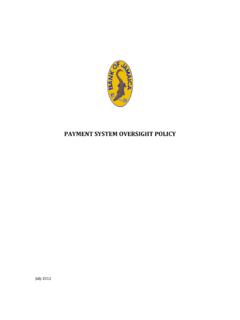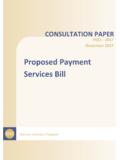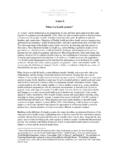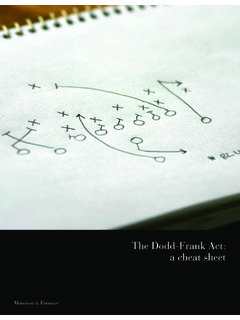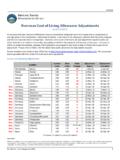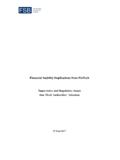Transcription of FINANCIAL INFRASTRUCTURE POLICY AND RESEARCH …
1 FINANCIAL INFRASTRUCTURE POLICY AND RESEARCH SERIES. FINANCIAL . INFRASTRUCTURE . Building Access Through Transparent and Stable FINANCIAL Systems 2009 The International Bank for Reconstruction and Development The World Bank 1818 H Street NW. Washington, DC 20433. Telephone 202-473-1000. Internet E-mail All rights reserved. 1 2 3 4 08 07 06 05. A publication of the World Bank and the International Finance Corporation. FINANCIAL INFRASTRUCTURE is a joint World Bank and International Finance Corporation (IFC). It was prepared by Margaret Miller, Nataliya Mylenko and Shalini Sankaranarayanan. Input on the document was provided by Michael Klein, Simeon Djankov, Peer Stein, and Massimo Cirasino. The team would also like to thank the following current and former World Bank Group colleagues for their insightful comments, guidance and support in writing this piece: Alejandro S. Alvarez de la Campa, Alison Harwood, Anjali Kumar, Asli Demirguc-Kunt, Bikki Randhawa, Carlo Corazza, Catherine Anne Hickey, Consolate K.
2 Rusagara, Everett Wohlers, Gregory Watson, Ketut Ariada Kusuma, Jose Antonio Garcia Garcia Luna, Neil Gregory, Roberto Rocha, Sevi Simavi, Tony Lythgoe, and Thorsten Beck. Book cover design/. production by Aichin Lim Jones and Michele de la Menardiere. Interior & graphs design/production by Aichin Lim Jones and James Quigley. This volume is a product of the staff of the World Bank Group. The findings, interpretations and conclusions expressed in this volume do not necessarily reflect the views of the Executive Directors of the World Bank or the governments they represent. The World Bank does not guarantee the accuracy of the data included in this work. Rights and Permissions The material in this publication is copyrighted. Copying and/or transmitting portions or all of this work without permission may be a violation of applicable law. The World Bank encourages dissemination of its work and will normally grant permission to reproduce portions of the work promptly.
3 For permission to photocopy or reprint any part of this work, please send a request with complete information to the Copyright Clearance Center, Inc., 222 Rosewood Drive, Danvers, MA 01923, USA; telephone 978-750-8400;. fax 978- 750-4470; Internet: All other queries on rights and licenses, including subsidiary rights, should be addressed to the Office of the Publisher, The World Bank, 1818 H Street NW, Washington, DC 20433, USA; fax: 202-522-2422; e-mail: pubrights Photo credits: Aichin Lim Jones, Getty Images, IFC Photo Library, Kabir Kumar-CGAP, and Peer Stein. FOREWORD i Contents Foreword Overview 1. The Reach of FINANCIAL INFRASTRUCTURE 4. Measuring FINANCIAL INFRASTRUCTURE 6. FINANCIAL System Soundness and FINANCIAL INFRASTRUCTURE 8. FINANCIAL Market Depth and FINANCIAL INFRASTRUCTURE 9. Efficiency of FINANCIAL Services and FINANCIAL INFRASTRUCTURE 10. Access to FINANCIAL Services and FINANCIAL INFRASTRUCTURE 12.
4 FINANCIAL INFRASTRUCTURE and the Crisis 14. How to Reform 15. Data Notes 19. References and Suggested Bibilography 21. ii FINANCIAL INFRASTRUCTURE . Foreword How do FINANCIAL institutions process Stable FINANCIAL Systems draws largely on bureaus, enforcement of collateral and payments, check a potential borrower's the Bank Group's efforts in the follow- functioning payment, securities settle- past experiences with credit or evaluate ing key areas: payment and securities ment, and remittance systems, often the suitability of a security interest to be settlement systems, remittances, credit do not exist or are underdeveloped in used for a loan? For many consumers in reporting, and secured transactions and emerging markets. These key elements the FINANCIAL marketplace, the answers collateral registries. It defines the space, are vital to facilitating greater access to these questions are taken for granted, and presents a literature review, an esti- to finance, improving transparency just part of the black box of tools and mate of the size of the market, develops and governance, as well as safeguard- technologies used by lenders as they an index for benchmarking FINANCIAL ing FINANCIAL stability in global FINANCIAL transfer funds between institutions or INFRASTRUCTURE , and discusses the impli- markets.
5 Decide on credit applications. In this cations of FINANCIAL INFRASTRUCTURE for black box are the different elements of access, transparency, better governance a country's FINANCIAL INFRASTRUCTURE . and stability in FINANCIAL markets. This The World Bank Group is a leader in report is aimed at POLICY makers, regula- FINANCIAL INFRASTRUCTURE development in tors, practitioners, academics as well as emerging markets, including payment other interested parties. systems and remittances, credit report- FINANCIAL INFRASTRUCTURE broadly ing and secured lending. Moreover, the defined comprises the underlying foun- Bank Group is intensifying its commit- dation for a country's FINANCIAL system. ment to promote and disseminate the It includes all institutions, information, POLICY and RESEARCH debate on these and technologies, rules and standards that other topics within the scope of finan- enable FINANCIAL intermediation.
6 Poor cial INFRASTRUCTURE , including corporate FINANCIAL INFRASTRUCTURE in many devel- governance, auditing and accounting oping countries poses a considerable standards and practices, and FINANCIAL constraint upon FINANCIAL institutions literacy. to expand their offering of FINANCIAL ser- Penelope J. Brook For this purpose, the FINANCIAL vices credit, savings and payment ser- ActingVice President INFRASTRUCTURE Series was launched in vices to underserved segments of the FINANCIAL & Private Sector Development mid-2008 to host original contributions population and the economy. It further World Bank Group in the form of POLICY notes, studies, and creates risks for the FINANCIAL system as a essays led by World Bank Group experts, whole, as poor payment and settlement as well as initiatives carried out in coop- systems may exacerbate FINANCIAL crises, eration with or by other experts and rel- while the absence of credit bureaus in evant institutions in the various fields of conjunction with strong credit growth Peer Stein FINANCIAL INFRASTRUCTURE .
7 May lead to one. Key FINANCIAL infra- Manager The report, FINANCIAL INFRASTRUCTURE . structure elements that every devel- Access to Finance Advisory Building Access Through Transparent and oped market can rely on, such as credit International Finance Corporation OVERVIEW 1. Overview FINANCIAL INFRASTRUCTURE (FI) is a core ing today and promise to lead the way in FIGURE 1. part of all FINANCIAL systems. The qual- defining the landscape of FINANCIAL mar- ity of FINANCIAL INFRASTRUCTURE deter- kets going forward. These innovations mines the efficiency of intermediation, usher in new benefits through increased Market the ability of lenders to evaluate risk and access points that make products and INFRASTRUCTURE of borrowers to obtain credit, insurance services more affordable and available to and other FINANCIAL products at com- all. Along with the benefits are the inher- Bank petitive terms. Strengthening FINANCIAL ent risks involved with the development Bank B.
8 INFRASTRUCTURE takes time, resources and of new products and delivery chan- A. political will, however, and so important nels, some of which have culminated in differences persist across countries. today's crisis, and the inherent need for Bank C. Access to finance is the result of a adequate regulation and oversight. complex interplay of different FINANCIAL intermediaries, the right kinds of finan- Credit Bureaus cial INFRASTRUCTURE , and a sound legal In the Philippines, just 5% of the popu- and regulatory framework. Expanding lation is included in the private credit access to finance and FINANCIAL services bureau. The corresponding figures for to those at the bottom of the pyramid India and the Russian Federation are entails a two-pronged strategy (i) double that of the Philippines 10% . firstly that of creating and improving but still quite low. Credit bureau cov- the different FINANCIAL INFRASTRUCTURE ele- erage is substantially higher, however, ments, such as credit bureaus, payment in some developing countries including and securities settlement systems, remit- Slovakia (40%), South Africa (65%), tances and collateral registries, as well as Mexico (71%), El Salvador (83%) and Credit bureaus, collateral registries, and pay- creating an enabling legal and regulatory Argentina (100%).
9 While Argentina's ment, remittance and securities settlement framework to allow the proper function- full coverage of the population is systems are all vital parts of a country's finan- ing of these various FINANCIAL infrastruc- unusual for developing countries, it cial INFRASTRUCTURE . When FINANCIAL infrastruc- ture elements; and (ii) working with is not unusual for developed ones. ture is available, efficient and reliable, the the various FINANCIAL institutions them- Australia, Canada, Iceland, Ireland, cost of FINANCIAL intermediation falls. FINANCIAL selves (retail/SME banks, microfinance, New Zealand, Norway, Sweden, the products and services become accessible to housing, leasing), and developing insti- , and the all have private credit greater numbers of citizens and lenders and tutional capacity within. Today's finan- bureau systems which cover their entire investors have greater confidence in their abil- cial market economy abounds with ity to evaluate and guard against risk.
10 Innovations in both products and deliv- ery channels that defy the traditional Definition of FINANCIAL INFRASTRUCTURE boundaries within which FINANCIAL mar- The underlying foundation for the FINANCIAL kets operated. Innovations in branchless system including the institutions, information, banking, mobile banking, and corre- technologies and rules and standards which spondent banking models, are all thriv- enable FINANCIAL intermediation. 2 FINANCIAL INFRASTRUCTURE . Payment, Remittance and Collateral FINANCIAL INFRASTRUCTURE and the Securities Settlement Systems The ability of lenders to use movable col- Current Crisis The development of payment sys- lateral as security for a loan also depends FINANCIAL INFRASTRUCTURE can help to tems INFRASTRUCTURE also varies greatly on the country. Data from Doing reduce risk and increase efficiency in between countries. Large value (typi- Business show that borrowers can, at FINANCIAL markets, but it can also some- cally inter-bank) payments handled on least theoretically, use movable collat- times contribute to situations where real time gross settlement (RTGS) pay- eral to secure a loan while retaining pos- excessive risks are taken.










